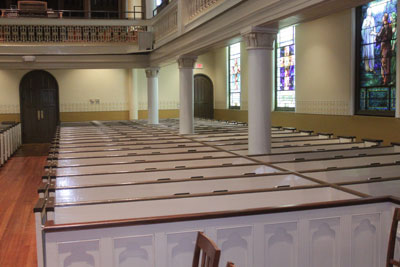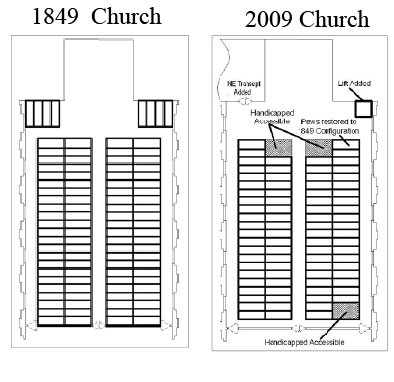
The Pews


Pews emerged at the time of the Protestant Reformation. The rise of the pulpit as the focal point of the church with the sermon as a central act of Christian worship, especially in Protestantism, made the pew an indispensable item of church furniture. It allowed the people to sit in stationary position, not looking at each other but looking at the pulpit, all facing the same direction. In the case of St. George's selling the pews both for the second church in 1815 and current or third church in 1849 provided needed financing to pay for the construction.
St. George’s Pews are boxed pews, encased in paneling as opposed to open pews. It is likely that this was a holdover from the first St. George’s in the 1730’s. Box pews provided privacy and allowed the family to sit together. The pews are original to the 1849 church. Due to their sturdy construction and the connection to the floor, they were not destroyed in the Civil War unlike some other churches in the area.
Besides they had other uses. “Men are lying in the pews, on the seats, on the floor, on boards on the top of the pews,” James Bowen wrote in 1864, when St. George’s served as a hospital.In 1849, there were 100 pews. The Church raised over $24,000 then ($500,000+ in today’s dollars) by selling 80% of the pews in 1849. The highest price pew #2 was purchased by the Mrs. Coalter for $460 ($10,000 to $12,000 in 2008 dollars). The lowest price of $200 was Pew 79 purchased by John Minor. Eliminating the two unknown prices the average price was $312. At first they were grained, gradually “darkened” after 1925 and finally painted in the early 1950’s.

Two sets of four pews flanked the pulpit on either side and were aligned parallel to the aisles. The remaining ninety-two pews, 8’, 8” long and 13” wide were arranged perpendicular to the aisles. Each individual pew was equipped with a door which opened into the adjacent aisle, and the floors of all the pews were raised approximately 4 inches above the level of the aisles. The center section of pews extended all the way to the rear wall of the nave and the only way to move from one aisle to the other was either in the narthex or at the front of the pews. At first they were grained, gradually “darkened” after 1925 and finally painted in the early 1950’s.
Pew ownership was demonstrated in a deed similar to real estate. Like real estate owners pew owners were taxed beginning shortly after the Civil War, a practice that continued until 1943. Book racks and kneelers appeared on the pews in 1947 as a memorial to Edgar M. Young, junior warden.
Over time the number of pews have decreased due to various needs and building within the church - a crossway needed in the rear, the addition of the northwest transept (1925), the addition of an elevator (2001) as well as handicapped pews (2008-2009):

2. Pews, Part 2, Design and changes
3. Pews, Part 3, Financing the Church
4. Pews, Part 4, Leading families of 1849
5. Pews, Part 5, The second generation